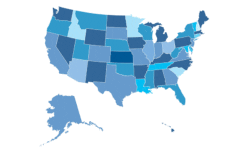FBI Releases 2006 Hate Crime Statistics
WASHINGTON – Statistics released Nov. 19 by the Federal Bureau of Investigation revealed that 7,722 criminal incidents involving 9,080 offenses were reported in 2006 as a result of bias against a particular race, religion, sexual orientation, ethnicity/national origin, or physical or mental disability. Published by the FBI’s Uniform Crime Reporting Program, Hate Crime Statistics, 2006, includes data from hate crime reports submitted by law enforcement agencies throughout the nation.
Hate Crime Statistics, 2006, includes the following information:
Analysis of the 7,720 single-bias incidents by bias motivation showed that 51.8 percent were motivated by a racial bias, 18.9 percent were motivated by a religious bias, 15.5 percent were triggered by a sexual-orientation bias, and 12.7 percent of the incidents were motivated by an ethnicity/national origin bias. One percent involved bias against a disability.
There were 5,449 hate crime offenses classified as crimes against persons in 2006. Intimidations accounted for 46 percent, simple assaults for 31.9 percent, and aggravated assaults for 21.6 percent. Three murder and non-negligent manslaughter offenses, as well as six forcible rapes, were reported as hate crimes.
Of the 3,593 hate crime offenses classified as crimes against property, the majority (81 percent) were acts of damage/destruction/vandalism. The remaining 19 percent of crimes against property consisted of robbery, burglary, larceny-theft, motor vehicle theft, arson, and other crimes.
According to data for the 7,330 known offenders reported in 2006, 58.6 percent were white, and 20.6 percent were black. The race was unknown for 12.9 percent, and other races accounted for the remaining known offenders.
The majority (31 percent) of hate crime incidents in 2006 occurred in or near residences or homes, followed by 18 percent on highways, roads, alleys, or streets; 12.2 percent at colleges or schools; 6.1 percent in parking lots or garages; and 3.9 percent at churches, synagogues, or temples. The remaining 28.8 percent of hate crime incidents occurred at other specified locations, multiple locations, or other/unknown locations.
Each year’s edition of Hate Crime Statistics presents data regarding incidents, offenses, victims, and offenders in reported crimes that were motivated in whole or in part by a bias against the victim’s perceived race, religion, ethnicity, sexual orientation, or disability.
Here’s an overview of the findings:
- Incidents and Offenses: A total of 7,722 incidents and 9,080 offenses were reported by participating agencies in 2006.
- Offense Type: Nationwide, 5,449 offenses were classified as crimes against persons, with intimidation (46 percent) and simple assaults (31.9 percent) accounting for most crimes. There were three murders during the year. Of the 3,593 crimes against property, the overwhelming majority (81 percent) were acts of vandalism or destruction.
- Offenders: Of the 7,330 known offenders, 58.6 percent were white and 20.6 percent were black.
- Victims: A total of 9,652 victims were identified. More than half-52.0 percent-were targeted because of their race.
- Locations: Most incidents, 31 percent, took place near or at homes and residences. Another 18 percent occurred on highways or streets.
For more information, please visit www.fbi.gov/ucr/hc2006/index.html.
To read the full report, please visit http://www.fbi.gov/ucr/hatecrime.pdf.
For the training guide, please visit http://www.fbi.gov/ucr/traingd99.pdf.
________________________________________________________________________________________
FBI Nov. 19 press release
If you appreciated this article and want to receive more valuable industry content like this, click here to sign up for our FREE digital newsletters!
 Leading in Turbulent Times: Effective Campus Public Safety Leadership for the 21st Century
Leading in Turbulent Times: Effective Campus Public Safety Leadership for the 21st Century
This new webcast will discuss how campus public safety leaders can effectively incorporate Clery Act, Title IX, customer service, “helicopter” parents, emergency notification, town-gown relationships, brand management, Greek Life, student recruitment, faculty, and more into their roles and develop the necessary skills to successfully lead their departments. Register today to attend this free webcast!







